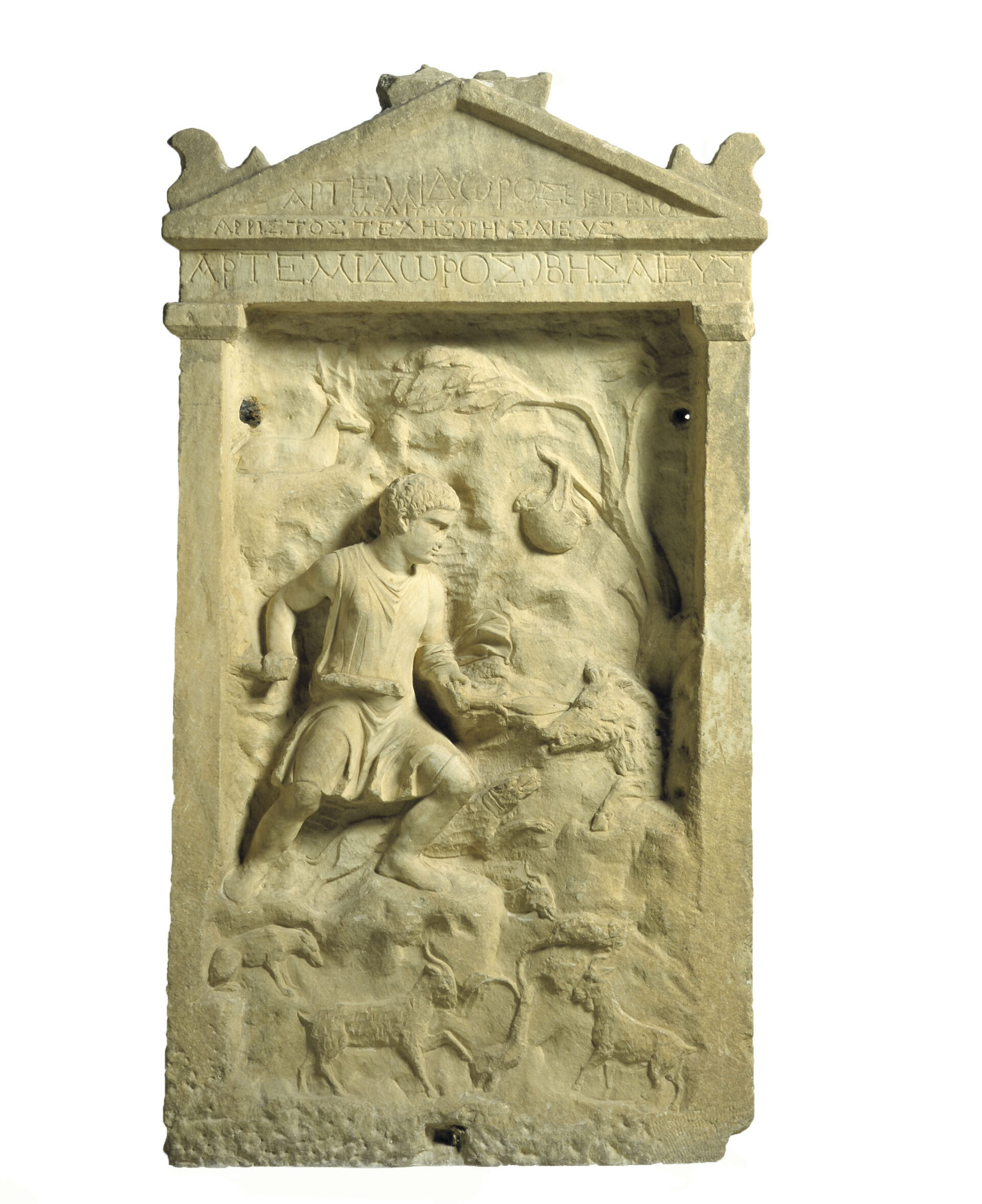Exhibit of the month
Entertainment and education of youth through hunting
The grave stele of Artemidorus
National Archaeological Museum, Sculpture Collection, inv. no. Γ 1192
Provenance: Athens, Olympieion
Dimensions: Height 1.43 m.
Date: 160-180 AD
Location: Sculpture Collection, Room 32
The marble stele is in the shape of a small temple with pediment. The relief that adorns it depicts a vivid scene of wild boar hunting in the forest. In the center of the scene, young Artemidorus rushes towards the prey, which he is ready to strike with the spear he holds firmly in both hands. The impetuous movement of his hunting dog, which also attacks its prey with intensity, is equally vividly rendered.
The uneven surface of the relief’s depth, the deer and the tree from which hangs the hunter’s swag, the goats grazing lower next to a second hunting dog, are indicative of the natural landscape where the hunting scene takes place. Artemidorus, rendered in frontal view, with his head facing the boar, wears a short, loosely belted tunic, a chlamys which is waving, wrapped around his left hand, and closed shoes. He has short hair and recognizable facial features. The intense, filled with action figures of the young hunter and his dog are contrasted with the feeble figure of the wild boar, which emerges carefree, adrift at the mercy of luck, to the right end of the scene.
The funerary use of the hunting theme in this case rightly imposes the prominence of the depicted young hunter at the expense of the terrible beast. The hunting prowess of Artemidorus is also indicated by the etymology of his name, meaning the one who enjoys the protection of Artemis, goddess of hunting and nature. It is possible, however, that Artemidorus was killed while hunting a boar, which justifies this representation on his grave stele. Three names are inscribed on the pediment drum, horizontal cornice and architrave, indicating that the stele was used successively for more deceased of the same family, who were apparently keen hunters.
Depictions of hunting have been known from the prehistoric times onwards. However, they rarely adorn grave stelae from Athens, both in Roman times and earlier. The sculptor of the Artemidorus stele adopts the theme of the mythical Calydonian boar hunt, known from the sarcophagi, but he innovates in the rendering of the young hunter, the animals and the natural landscape. Relief representations of hunting boars, lions or deer, often decorate the Attic sarcophagi of the Roman times [1].
“Static” depictions of young hunters are quite common on grave stelae of the Classical period from Athens. They reflect the ancient Greeks’ beliefs on the role of hunting in educating young people and preparing them for war, which was equivalent to athletics.
The most significant ancient manual for the subject is Xenophon’s Kynegetikos (On Hunting). It describes in detail how hunting was conducted in ancient Greece at the end of the 5th and the beginning of the 4th cent. BC. The manual is addressed to young people and highlights the benefits they can obtain through their involvement in hunting, regarding the development of their moral, physical and martial abilities.
Dr. Evridiki Leka
Bibliography
D.W. von Mock, Die figürlichen Grabstelen Attikas in der Kaiserzeit (Mainz a. R. 1998) 121, no. 205, pl. 25d, 26a-b.
N. Kaltsas, National Archaeological Museum. The sculptures (Athens 2001) 353, no. 747.
G. Kokkorou-Alevras, Δραστηριότητες των αττικών εργαστηρίων γλυπτικής την εποχή της Ρωμαιοκρατίας, in: A. Alexandris – I. Leventis (ed.), Καλλίστευμα. Μελέτες προς τιμήν της Όλγας Τζάχου-Αλεξανδρή (Αthens 2001) 336, fig. 18.


